| Bhutan's Economy: Agriculture |
 |
Bhutan Agriculture |
|
 |
Bhutan Information |
|
|
 |
| Agriculture |
|
|
Zhemgang:
Harvesting the old way
|

|
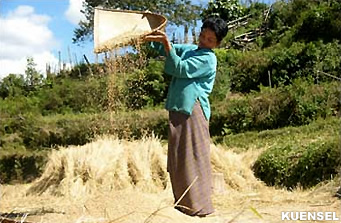 |
| Separating grain from husk by winnowing |
| Harvesting
paddy is not just about cutting ripened stalks and shaking off the grain.
Besides the long hours of back - breaking manual work in the sun there
is a particular tradition, built through the ages on myth and belief, to
reap what is sown.
And
in central Bhutan's Zhemgang dzongkhag, as in many other places,
paddy is still harvested the traditional way. |
|
On
the first day farmers use the sickle to cut the stalks which are arranged
in rows and left in the field for the night. On the second day a bamboo
mat called pari is spread on the field on which the paddy stalks are stacked
in a pile.
On
the third and final day three sticks called Kang sum in Khengkha, are tied
together and spread out flat on the ground in the shape of a triangle.
On the Kang sum is placed the Yang dho (a round and flat stone) on which
the paddy stalks is hit to start the process of separating the grain from
the straw.
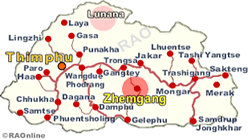 |
| Cloth
and sheets of plastic are hung around the Yang dho like a curtain to prevent
the paddy grains from jumping out too far during threshing.
The
Khengpas of Zhemgang believe that the Yang dho should not be changed until
and unless it is broken. Some people own Yang dhos, which are more than
around three generations old. |
|
|
"I
use the Yang dho used by my grandparents and I do not lend it to others
as we believe that using old Yang dhos gives us a better yield," said Yeshila,
52, from Dangkhar. "We also believe that if we lend it out our yield will
be shared by those who borrow it."
When
the paddy is threshed the farmers sing a song called Babshi, "God of good
yield, grant me better yield"
The
threshing process starts with a handful of paddy stalks being hit against
the Yang dho. It is then passed around to several people seated close by
who hit the stalks in turns with a stick to remove the grain. |
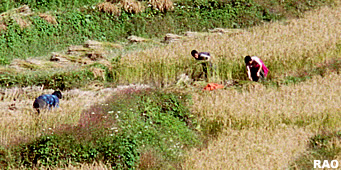 |
| Harvesting in Damji (Gasa dzonghag) |
| By
evening, when threshing is done, the grain is covered and left in the field.
The process of winnowing, where the grain is separated from the husk, is
done the next day by gently pouring the grain to the ground against a breeze.
On calm days farmers whistle to call the wind to aid winnowing. |
|
The
grains are then packed in sacks and measured in dreys (three kgs equals
two dreys) to judge the yield.
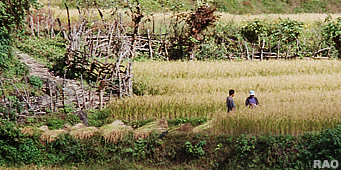 |
| Harvesting in Damji (Gasa dzonghag) |
|
The
threshing process starts with a handful of paddy stalks being hit against
the Yang dho. It is then passed around to several people seated close by
who hit the stalks in turns with a stick to remove the grain.
By
evening, when threshing is done, the grain is covered and left in the field.
|
|
The process of winnowing, where the grain is separated from the husk, is
done the next day by gently pouring the grain to the ground against a breeze.
On calm days farmers whistle to call the wind to aid winnowing.
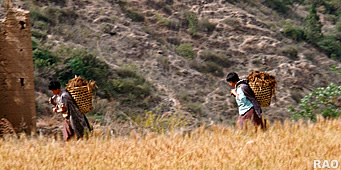 |
| Harvesting in Lobesa (near Punkha) |
|
The
grains are then packed in sacks and measured in dreys (three kgs equals
two dreys) to judge the yield. Before the grain is poured into the big
storage containers in the house the farmer burns incense in appreciation
for another harvest. |
|
The
straw, which are tied in bunches and left to dry in the fields are fed
to the cattle during the winters.
Sometimes,
paddy is harvested even before it is fully ripened because of destruction
by wild animals. The crop is sown in nursery beds in March and transplanted
in April - June. It is harvested in September and October.
Paddy
is an important cereal for the people of Zhemgang. The grain is also used
to make wine and changkoe (a local brew made of rice) for special occasions
like the annual rites known as Lochoes.f rice) for special occasions like
the annual rites known as Lochoes.nds," he said. "And there are no places
to go to from Tshimalakha. Gedu will remain as it is, at least if it doesn't
grow."
| This
article was contributed by Nima Wangdi, KUENSEL, Bhutan's National
Newspaper, 2006 |
 |
top
|
Harvesting
in Bhutan
|

|
top
| Information on Bhutan |
 |
|












